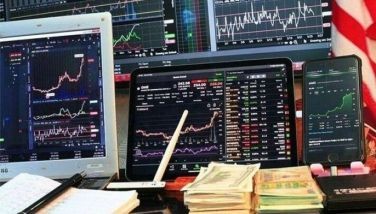Anatomy of a correction
After another run-up, the PSE Index experienced its second meaningful correction for the year. This time around, the index dropped more than 1,000 points from peak to trough. After reaching an intraday all-time high of 7,404 on May 15, this correction has so far carried our index to an intraday low of 6,394 on June 6. Two days after reaching the low, the PSE Index bounced back to close the week at 6,702. Despite this bounce, many clients and investors are wondering why the index fell so much in a span of three weeks. In this article, we shall discuss the reasons behind this recent correction.
QE tapering
The main trigger of this correction is the talk of the tapering of the US Fed’s quantitative easing (QE). In past articles, we talked about the Fed’s unconventional monetary policy, which is aimed at supporting the US economic recovery (The Rescue, Sept. 22, 2008 and The Twist, Sept. 26, 2011). With this unprecedented liquidity injection into the economy, the Fed’s QE has also buoyed the appetite for risk assets all over the world. Since the Fed was followed by other global central banks, this great global monetary easing (The Great Global Monetary Easing, Oct. 22, 2012) has led to a global bull market in stocks (Global Bull Market, Jan. 7, 2013).
As the US economic recovery gains some traction, Fed chairman Ben Bernanke said on May 22 that QE might be tapered in the next few meetings, which could be anywhere between two to four months. It also came out in the minutes of the Fed meeting that some Fed members were open to tapering the Fed’s QE program. QE tapering refers to the reduction of the Fed’s monthly bond purchases and a gradual shift from aggressive monetary easing to a tighter monetary policy.
We know that QE has fueled the US economic recovery and a global bull market in stocks. QE tapering is long-term positive because it suggests that the economy is on stronger footing. However, there is much uncertainty on how it will affect interest rates, bonds and stocks in the short-term.
Dollar strength and rising bond yields
With what we are seeing now, it is apparent that the US is ahead in terms of monetary policy compared to most developed countries. Considering this, it is likely that the US will exit from monetary policy easing earlier than most of its peers.
This has led to the strengthening of the US dollar and consequently, the weakness of various emerging market currencies such as the Philippine peso (The peso tops out, May 27, 2013). Though this phenomenon has prevented the peso from over-strengthening, a weaker peso has lessened the portfolio returns of foreign investors who typically look at dollar portfolio returns. The sudden movement of the peso has prompted some foreign investors to take some profits and trim down their exposure to Philippine stocks.
Moreover, the mere expectation of a reduction in the Fed’s bond purchases has led to rising bond yields not only in the US but all over the world. This caused a selloff in the bonds of different countries.
Japan’s correction
Japan is one of the countries that were hit by rising bond yields. Since the yields on Japanese government bonds (JGBs) are among the lowest in the world, a spike in bond yields caused a major selloff in JGBs. This ultimately triggered the first steep correction that the Nikkei has encountered since its run-up that started in November 2012.
The Nikkei has benefited from a possible turnaround in the Japanese economy. Because of the ambitious plans of Japanese Prime Minister Shinzo Abe and Bank of Japan Governor Haruhiko Kuroda, there has been a lot of hope that Japan would finally get out of its 20-year deflationary trap (Out of the sandtrap, April 15, 2013). These plans ultimately drove the Nikkei’s run-up.
At its 2013 high, the Nikkei was more than 50 percent higher vs. last year’s close. Even after falling 19 percent from the peak, the Nikkei is still up 24 percent year-to-date (YTD) and is still the best performing stock market in the world. Considering the Nikkei’s steep run-up, experiencing a correction is natural and actually healthier. During its run-up, the Nikkei pulled other Asian stock markets higher. Consequently, its steep correction precipitated similar corrections in the stock markets of neighboring countries such as the Philippines.
Too fast, too soon, too steep
Like the Nikkei, the PSE Index was performing strongly before this correction started. Our index was the second best performing stock market in the world behind the Nikkei. At the peak of 7,404, our index was already very close to our yearend target of 7,500 (How to join the bull party, Feb. 25, 2013). At this level, the PSE Index was 27 percent higher vs. last year’s close. Moreover, at the peak, our index traded at more than 20x 2014E PE even though we have not reached the halfway mark of the year. Note that these were achieved in just 4 ½ months of trading. Even though we are bullish on Philippine stocks over the long-term, the run-up of our index was simply too fast, too soon and too steep.
A torrent of shares
Aside from the reasons that we discussed, our index declined because the supply of shares in the market overpowered the demand for them. Below, we explain how this happened.
1. Heavy foreign selling. The talk of QE tapering, the stronger dollar and Japan’s sharp correction have prompted foreign investors to take some risk off the table. Among the most hit were emerging market stocks and the Philippines was no exception. From the start of the correction on May 23 up to June 7, we estimate that net foreign selling of Philippine stocks has amounted to P16 billion.
2. Share issuances. As with last year, listed companies continued to take advantage of our stock market’s continued strong performance. These share issuances came via backdoor listings, secondary placements and initial public offerings (IPOs). YTD, these amounted to ~P136 billion. For April and May 2013, share issuances exceeded P92 billion. The huge volume of these share issuances sapped a lot of liquidity from the stock market and contributed to the decline of our index.
3. MSCI rebalancing. MSCI’s semi-annual rebalancing calls for the addition or deletion of certain stocks in the equity portfolios of foreign investors. This may also involve the increase or decrease in the weightings of the stocks or countries covered by MSCI. This time around, the addition and deletion of local stocks in the MSCI Small Cap Index did more harm than good.
For this rebalancing, MSCI called for the deletion of GTCAP, MEG, PGOLD, RLC and SECB from its Small Cap Index. This move prompted foreign investors to sell these stocks down. Note that these are liquid stocks that are widely held by both foreign and local investors. The selloff on these stocks therefore contributed to this most recent correction.
MSCI replaced the said stocks with DNL, EEI, PF, PIP and RFM. Some of these stocks moved strongly on the back of their inclusion in the MSCI Small Cap Index. However, this did not benefit a lot of investors because these are relatively illiquid issues that are not widely held by the public.
6,300 to 6,500: buying window
We have repeatedly said that corrections can offer attractive buying windows. This is especially true if the fundamentals remain intact despite the correction – as the case is for the Philippines. In our Philequity board meeting last week, we presented attractive buying levels for each of the index constituents. We determined these buying levels for each of the index stocks using fundamentals. Based on these prices, we derived 6,323 as an attractive buying level for the index as a whole. Incidentally, this level is very close to the intraday low of 6,310 that was reached during the Cyprus Correction (The Cyprus Correction, March 25, 2013). Based on technicals, we think that 6,300 to 6,500 may provide an attractive buying range.
Trading the corrections
Time and again, we have said that corrections are extremely hard to catch. Since there are many factors that affect corrections, it is difficult to predict when they will happen, how deep they will be and how long they will last. Even experienced traders and investors can sometimes get caught off-guard with the sudden incidence of stock market corrections.
Since the correction interrupted the bullish move of the index, we advise investors to review their investment goals along with their asset allocation and equity exposure. We would advise short-term traders to be quick and nimble since the market can be very volatile during corrections. Long-term investors, on the other hand, can stay the course and rely on the fact that our secular bull market is intact and our structural growth story remains strong. Those who are underexposed to local stocks can buy on dips or buy in tranches in order to build equity exposure with a low cost base. Those who are heavily exposed to equities may take this chance to realize some profits and lighten-up. What is important is for investors to maintain exposure levels that are consistent with their investment goals, time horizon and risk tolerance. At the end of the day, investors should maintain exposure levels that will allow them to sleep well at night in times of volatility and corrections.
Please visit our online trading platform at www.wealthsec.com or call 634-5038 for detailed stock market research.
You can also visit www.philequity.net to learn more about the Philequity Fund and view our archived articles.
You can email us at [email protected] for feedback on the Philequity Corner articles.
- Latest
- Trending


























